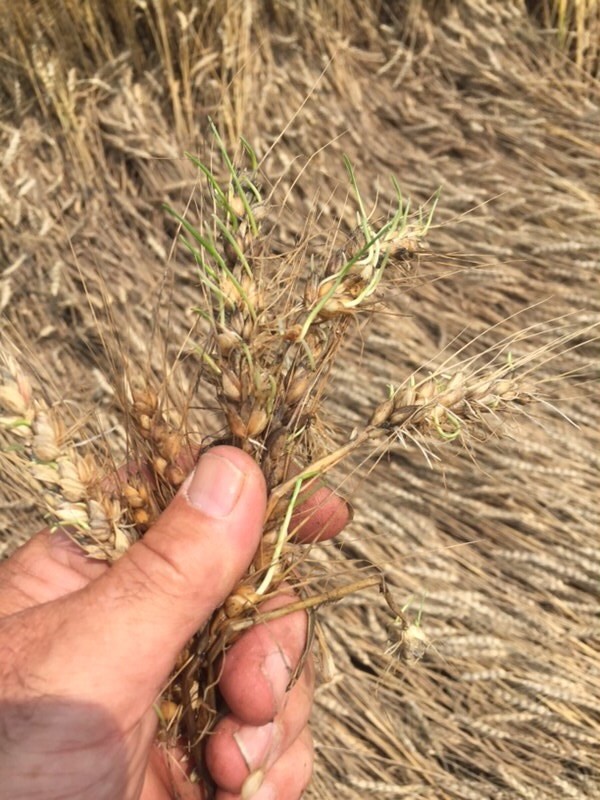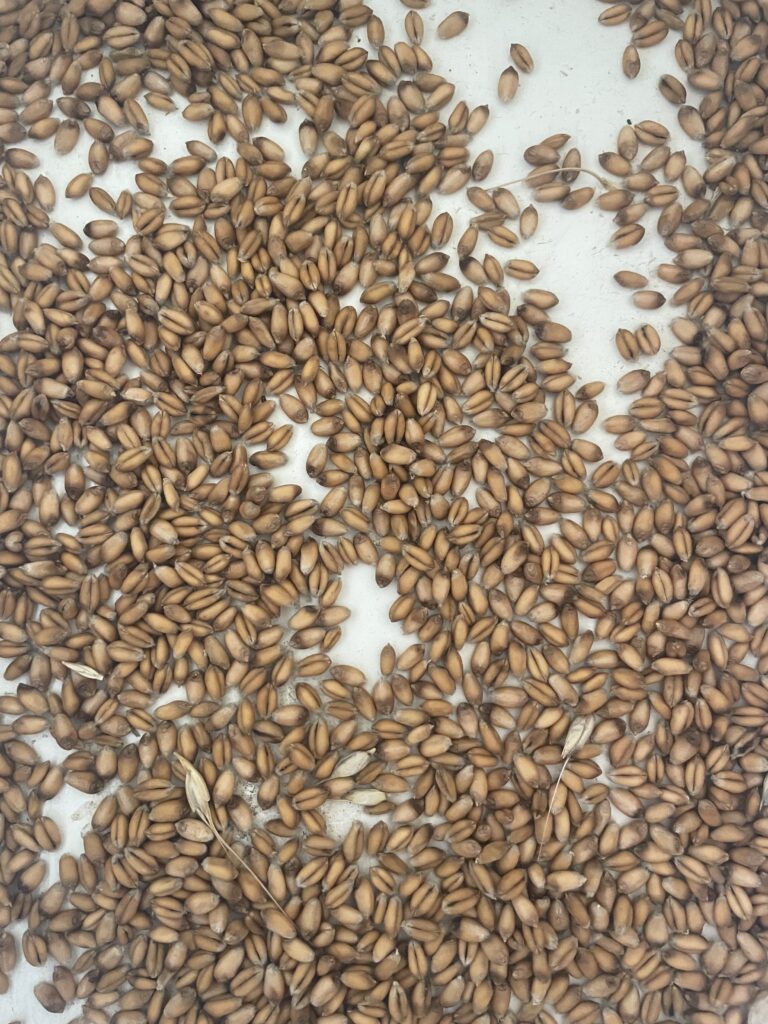Co-authored with Albert Tenuta, Pathologist, Field Crops and Peter Johnson, Agronomist, RealAgriculture
Fusarium Head Blight Management
Managing Fusarium head blight (FHB), also known as scab, in wheat is crucial to prevent yield loss, reduce mycotoxin contamination and maximize grain quality.
Identification
Fusarium Head Blight (FHB) symptoms are noticeable soon after flowering. Diseased spikelets (glumes and florets) appear to have ripened prematurely (bleached) in contrast to healthy, green heads (Figure 1). The fungus may attack all or only part of the head. FHB symptoms can occur under favourable conditions 3-5 days after infection which later leads to bleaching of heads. The entire head may be killed when the peduncle (the stem immediately below the head) is infected. During warm, humid weather, the fungus produces a salmon-orange-to-pink ring of spores at the base of the spikelet or in the crease of the kernel. If conditions continue, the infection may spread to adjacent kernels. Infected kernels are usually shrunken, wrinkled and light in weight. These kernels have a rough, scabby appearance and range in colour from light brown to pink to greyish-white. The amount of scab on the seed depends on the time of infection and the weather conditions at the time of infection.

Assessing Risk for FHB and DON Before Harvest
Winter wheat is most susceptible to FHB infection during the flowering period. Spores are carried from infected crop residue by wind or rain and splash onto the wheat head. Rainfall or heavy dew during this period causes the spores to germinate and infect florets on the wheat head. Given the prolonged wet conditions in many areas this growing season, the risk for infection may be higher than normal, this year.
If your wheat crop was planted after corn or wheat or a susceptible variety was planted, your risk of FHB infection is greater. To determine the susceptibility of a variety please visit www.GoCrops.ca. Fields that are lodged are also at greater risk. Research from Nakajima, T. et al, 2008 found that DON levels were increased by 27-51% at harvest in wheat that was lodged for just 5 days before harvest compared to wheat that did not lodge. The DON levels were even higher in wheat lodged for more than 5 days before harvest.
Assessing the level of infection in winter wheat fields to help prioritize harvest plans, is critical to maximizing quality and minimizing DON. To conduct an assessment, blindly grab 10 heads and count the number of heads with any level of infection to give the percent incidence (e.g. 1 head out of 10 infected = 10% incidence). From there the percent severity can be estimated by looking at how much of the head is infected (e.g. 6 spikelets infected out of 22 = 27% severity). The incidence is then multiplied by the severity and is divided by 100 (e.g. 10 x 27 = 270/100 = 2.7 Fusarium Index). Repeat this process at 10 locations in the field to arrive at a field level FHB index. In work published by Falk, D. et al, 2008, a fusarium index of 3 could result in DON levels >6 ppm in a high pressure fusarium year. If fields have a FHB index of greater than 2 they should be prioritized at harvest.

Harvest Management
Prioritize fields with high FHB index scores for harvest. Harvest should begin as soon as the combine is able to thresh the crop (even above 20% moisture). Fusarium can continue to grow whenever grain moisture is above 19%. Toxin levels can almost double with one rainstorm (Johnson, 2004). One caveat is that above 18% moisture some combines have difficulty blowing out the lighter Fusarium-damaged kernels. Growers must then make the call to wait and risk further spread or combine, dry and remove small kernels with aspiration.
1. Harvest Speed
Reducing combine travel speed can reduce Fusarium levels. Slower combining speed reduces the amount of material on the cleaning sieve and allows time to separate the good kernels from the infected kernels.
2. Fan Speed
Kernels with initial Fusarium infection are small, shrunken and lighter than sound kernels. It is possible to blow a large proportion of these Fusarium-damaged kernels out the back of the combine by increasing the fan speed to deliver an air blast above normal ranges.
Testing at Ridgetown in 1996 found that high fan speeds removed a significant percentage of tombstone kernels caused by primary Fusarium infection (Table 1). There was a tenfold decrease in Fusarium-damaged kernels in the grain sample when fan speeds were operated to deliver maximum air blast. Operating cleaning fans at these high speeds causes an additional loss of good kernels, up to 2 bushels per acre (0.13 t/ha). This small yield reduction is insignificant if the crop can be made marketable, rather than being downgraded to feed, sample or salvage. Start harvest at maximum cleaning fan speed but be cautious as newer combines may blow all the grain out the back. Check both the sample and losses and reduce the fan speed if necessary and again evaluate your harvest sample for Fusarium-Damaged Kernels (FDK). A 2011 Ohio study adds support to this result (http://apsjournals.apsnet.org/doi/abs/10.1094/PDIS-04-11-0309).
Table 1. Effect of different fan speeds on wheat yields. Schaafsma et al., 1996.
| Fan Speed (rpm) | ||||
| 1,160 | 1,220 | 1,280 | 1,330 | |
| Sieve Setting: (1/4″) | ||||
| Good kernels on ground: (/ft2) | 16 | 31.6 | 35.2 | 43.6 |
| Loss: (bu/ac) | 0.83 | 1.58 | 1.76 | 2.18 |
| Loss at 60 bu yield: % | 1.38 | 2.63 | 2.93 | 3.63 |
3. Chafer Setting
Consider adjusting the cleaning sieves (chaffer) to a more wide-open setting. This directs the air blast vertically, slowing the rearward movement of the grain mass and aiding cleaning and separation. Caution must be used to keep wheat heads and straw pieces out of the grain sample if the chaffer is opened.
4. Dry Grain above 16% Using Heat
Fusarium can continue to develop in the grain when moisture is over 19%. Immediate drying of tough grain arrests further Fusarium development. To maintain milling quality follow the recommendations in Table 2. The baking quality of wheat is damaged if the temperature of the grain reaches 60°C (140°F). The kernel temperature of the grain is not the same as the plenum temperature of the dryer. Kernel temperature can be measured by putting a sample of grain in a steel can and placing the thermometer in the centre of the sample. When heated air dryers are used, it is a worthwhile precaution to have samples evaluated to ensure the dried grain meets market standards.
Table 2. Maximum Recommended Air Temperatures for Drying Milling Wheat1
| Maximum Temperature | ||
| Dryer Type or End Use | ºC | ºF |
| Non-recirculating batch dryers | 60 | 140 |
| Recirculating batch dryers | 60-70 | 140-158 |
| Cross-flow dryers | 60 | 140 |
| Parallel-flow dryers | 70 | 158 |
| Seed Wheat | 40 | 104 |
Sprouting and Falling Number Management
Pre-harvest sprouting can be a concern if persistent rainfall events continue through to maturity and beyond. Pre-harvest sprouting can result in downgraded wheat at the elevator due to a low falling number. Pre-harvest sprouting can be initiated by cool, rainy conditions once wheat has reached physiological maturity (Figure 3). When there are multiple rain delays, there is an even greater risk for sprouting, even for varieties with good sprouting resistance. Hard red wheat is generally more tolerant to pre-harvest sprouts while soft white wheat is extremely vulnerable. Previous Ontario research showed that when harvest was delayed by two weeks the amount of sprouted wheat increased by almost 10% and yield was reduced by almost 4 bushels/acre (Table 2). In 2021, many areas received persistent rainfall once wheat reached physiological maturity, resulting in increased sprouts and low falling numbers across the province.
Table 2. The impact of delayed harvest on sprouts in winter wheat. Johnson et al. 2011.
| Harvest Date | Yield (bu/ac) | Test Weight (lb/bu) | Sprouts (%) |
| July 13 | 92.4 | 62.0 | 0.0 |
| July 18 | 91.8 | 61.3 | 0.0 |
| July 21 | 91.7 | 60.4 | 2.3 |
| August 1 | 88.7 | 57.8 | 8.8 |

Low falling numbers can also be caused by late maturity alpha-amylase (LMA) production. LMA production is triggered by cold or heat shock during the later stages of maturity (26 to 30 days after pollen shedding). However, the specific temperature swing needed to induce LMA is not known.
Wheat is considered sound and satisfactory for most milling and baking processes with a falling number of about 300 seconds; however, levels as low as 250 can be acceptable to end users. While growers are given a grade based on sprouts, mills are increasingly looking at falling numbers as an indicator of wheat quality. As a result, growers are encouraged to review all contracts to ensure they are aware of falling number or any other quality requirements upon delivery of grain.
The best defense against sprouting and low falling numbers is to harvest wheat as quickly as possible once it reaches maturity. Harvesting early and drying your grain is the most effective means of avoiding sprouting. Selecting pre-harvest sprouting resistant wheat varieties can also help reduce risks. Avoid mixing wheat with low and high falling numbers: the low falling number wheat will override the sound wheat, reducing falling number of the blend well below the average of the two samples. This will not result in a better falling number. Sprouted wheat or wheat with a low falling number should be kept separate from sound wheat. If storing wheat on-farm for later shipment, consider submitting a grain sample to a wheat testing lab for falling number analysis.
Black Point
As wheat matures and tissue begins to die, fields have turned black from Alternaria species in previous years. This can be particularly prevalent in those fields that do not receive a T3 fungicide with active ingredients effective on Alternaria; fields that are prone to premature seed senescence; and lodged fields. These fields should be the first harvested as this pathogen can cause black point and lower grain quality.
While black point does not have a negative impact on yield, it causes kernels to develop a black, smudge-like discolouration usually on the embryo (germ) end (Figure 4). This discolouration then results in wheat being downgraded because the black point infected kernels will cause the flour to turn grey during the milling process, making it undesirable to end users. Black point is particularly challenging during wet, warm weather during the grain fill period. It does not produce spores and will continue to grow on living tissue. Timely harvest is the most effective management strategy for reducing its progression.

Production Insurance may compensate affected winter wheat growers by applying a quality factor to low-grade wheat yields to reflect the lower prices received for these crops. The following link shows an example of how the coverage works. Production Insurance customers who experience winter wheat quality downgrades should contact Agricorp.
Customers can report yields by phone, fax, mail or email by September 1, 2023. The sooner yields are reported, the sooner any claims can be paid.
Website: Agricorp.com; Telephone (Mon. to Fri., 8:00 a.m. to 4:30 p.m.), 1-888-247-4999, TTY: 1-877-275-1380 or Email contact@agricorp.com
Sources:
Ontario Crop IPM – FHB in Wheat
Pre-Harvest Sprouting in Winter Wheat – Field Crop News
Fusarium Head Blight (FHB) of Wheat and Barley, Management Recommendations- YouTube
Management of Fusarium Head Blight In Wheat (North Dakota State University) – YouTube